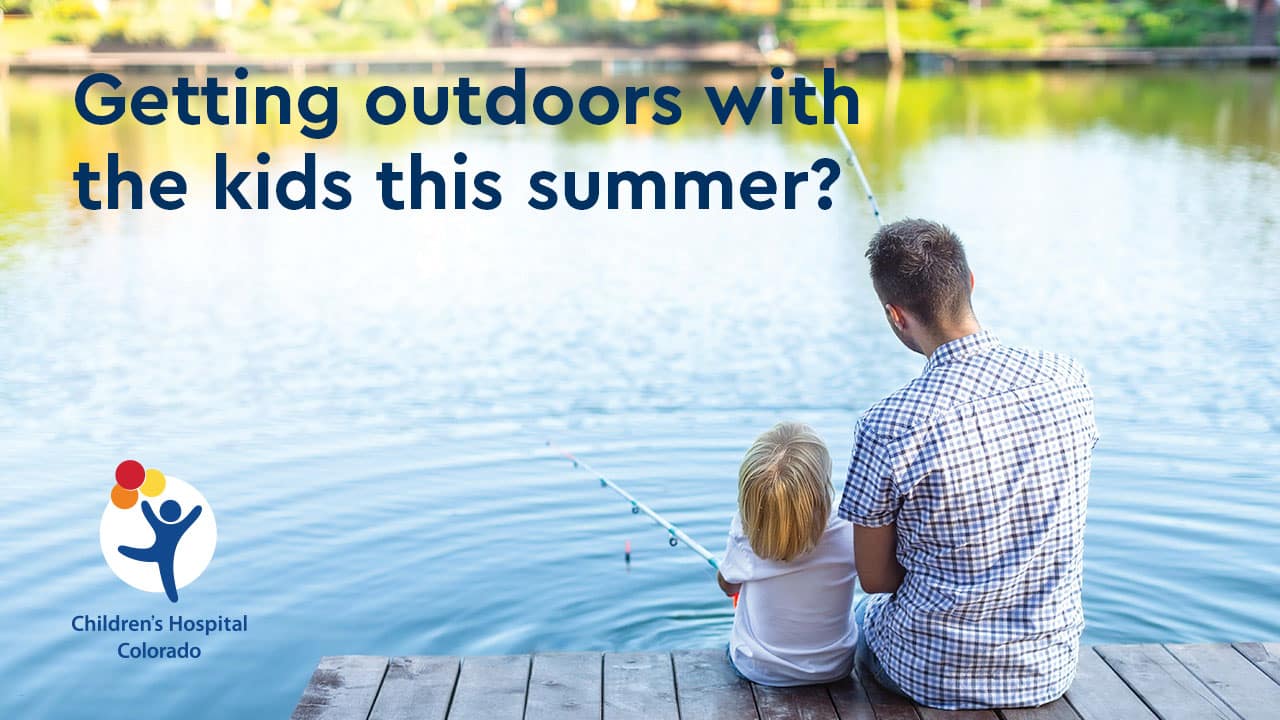One of the best parts of living in Colorado is taking advantage of all the state has to offer in the great outdoors. After all, the Rocky Mountains are in our backyard. In this post, experts from Children's Hospital Colorado provide excellent tips on how to best prepare for each outdoor adventure at all different age groups. Make sure you stay safe but most importantly, have some fun!
If you’ve decided it’s time to get your kids outside for something more adventurous than the local park, good for you. Exploring the outdoors can be very beneficial and rewarding for kids, but you need to be prepared.
Pediatric sports medicine specialist Aaron Provance, MD, understands the need to get kids outside. In addition to his expertise in pediatrics, he’s a seasoned mountaineer, mountain biker, backcountry skier, ice climber and big advocate for getting kids into nature. He’s also a father of triplets, so he’s realistic about what an outdoor excursion with kids entails.
“The key is having fun,” he says. “If they’re not having fun, you’re not going to want to do it again.”
For everyone’s enjoyment, Dr. Provance offers a few tips and tricks for preparing, staying safe and having a good time with kids of any age on any type of mountain excursion.
Hiking with kids
By age: “Hiking is something you can do with really young kids,” says Dr. Provance. “Just know your limitations.” Gauge the distance you’ll be walking by a realistic sense of how far your kids can walk without burning out — keeping in mind that for most hikes, you’ll need to double the distance for the way out.
Staying safe: At lower altitudes, especially on warmer days, prepare for the risks of dehydration and heat exhaustion. At higher altitudes, be prepared for all weather. “You could have a snowstorm in August in Rocky Mountain National Park, and all of a sudden you’re dealing with the possibility of hypothermia,” says Dr. Provance.
Prepare: Bring jackets, hats and gloves, even if it’s warm when you leave the house. “And if you don’t have snacks and water,” says Dr. Provance, “you’re doomed.” Bring more than you think you’ll need.
Word to the wise: Pacing is everything. Kids might get excited and want to run at first. Slow them down: A worn-out, exhausted kid will not have fun later in the hike. And be willing to slow down for them: Let them dawdle, rest and stop to look at interesting stuff. Finally, for younger kids, avoid getting in too deep. “Be willing and prepared to pull them out of the mountains quickly and retreat to the comforts of home,” says Dr. Provance.
Mountaineering with kids
By age: When you’re hiking into remote backcountry, at very high altitudes or you're dealing with increased technical difficulty — summiting a fourteener, for example — that’s mountaineering. A kid’s readiness depends on the experience and ability of both the kid and the parent. “Say you’re the only parent taking kids out into the mountains, and you fall and hit your head,” says Dr. Provance. “Do they know how to get out? Or to get help and get you out?”
Staying safe: Make sure kids know what to do and can do it if worst comes to worst. And when hiking at high altitude, always turn around between noon and 1 p.m., even if you don’t reach the summit. Storms and lightning tend to pick up in the afternoon. Prepare: The right clothing is key. Avoid material that retains moisture, like cotton, and favor layers. Temperatures can quickly change. Include a waterproof jacket, hat and gloves, even in the summer. Pack all the food you’ll need for the day, plus an extra meal in case you get stranded or lost. The mountains can be dangerous, and both parents and kids should be familiar with the risks before trying an excursion. Interested parents might try a class before planning your trip.
Word to the wise: “Reading reviews and other trip reports online can give you insight on what to expect,” says Dr. Provance. And if you don't have experience with the level of remoteness or difficulty, it’s probably not a good idea to bring a kid along for the first time. Finally, an appropriate pack is key. “If their pack isn’t fitting correctly or is too heavy, that can make for a terrible trip right off the bat.”
Rock climbing with kids
By age: “If parents are avid climbers and can set up a safe anchor system in a beginner area, some parents will start kids climbing at 3 to 5 years old,” says Dr. Provance. Obviously, that’s not for everybody. Because climbing requires a significant amount of technical knowledge and skill, parents’ preparation is probably more important than the age of the kids.
Staying safe: The most important piece of gear is an actual climbing helmet, not a bike helmet or any other kind. A climbing helmet is specifically designed to absorb the impact of falling rock.
Prepare: Rock climbing is equipment-intensive, so parents who don’t own it already might want to test the waters before they invest. Indoor climbing gyms offer a great place for climbers to build skill in a safe, equipped environment, without the threat of a rock fall or changing weather. Many of these gyms offer classes.
Mountain biking with kids
By age: The biggest factor for mountain biking is the ratio of skill level to the difficulty of the trail, regardless of age. Kids also need a healthy knowledge of and ability to abide by trail etiquette.
Staying safe: The most significant risk in mountain biking is going over the handlebars and sustaining a shoulder injury, clavicle fracture or concussion. Kids need the ability to roll over or jump obstacles like rocks and logs before taking on difficult trails. And, of course, always wear a helmet.
Prepare: Know the route, elevation gain and difficulty in advance. Websites like mtbproject.com can help you get an idea of what to expect.
Kayaking and rafting with kids
By age: Even very young children can raft an easy river — provided the adults on hand have all the knowledge, ability and equipment to do it safely. Parents less familiar with the skills and risks of the river may want a guided tour. Age limits will apply. Staying safe: The American Whitewater Association classifies rivers based on difficulty (which may vary based on time of year, as changes in water level affect difficulty level). Until kids are fairly strong swimmers with experience on the water, it’s probably best to stick to class I or II.
Prepare: The single most important item for anything on the water is a Coast Guard-rated life jacket that fits well and is appropriate for your child’s weight. Your child needs to be comfortable wearing it, even on a guided tour. If you’re whitewater rafting, be sure you and your children wear helmets, too.
Word to the wise: Unless you’ve actually organized and executed a raft trip on your own, don’t try it with kids. Do a guided tour instead. Colorado offers dozens of them.
Fishing with kids
By age: Fishing is safe and fun for kids of almost any age — as soon as they can handle a pole (and mind the hook).
Staying safe: “The main risk would be getting into a stream that’s too swift or too deep,” says Dr. Provance. “Especially if they’re wearing waders, which can fill with water, increasing the risk of drowning.” For younger kids, it’s probably best to stick to mountain lakes and calm streams.
Word to the wise: Fishing is a great opportunity to teach kids about the ethics of catch-and release — and of the mountains themselves.
What to bring on outdoor adventures
Every great adventure requires a thorough packing list. You’ll want these essentials for your mountain excursions:
- Sunscreen
- Insect repellant
- Lots of water
- Snacks
- First-aid kit that is up to date
- Extra clothing
- Gloves and hats
- Map or GPS device
- Cell phone
- Fire starter

